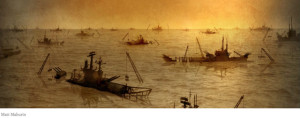Okay, so Rolling Stone is taking a beating right now for the UVA rape story. I’m sure the right will want to make a big deal out of this. Fair enough. I got not problem with that so long as they also recognize that their guy Bill O’Reilly has some holes in some of his stories.
Anyway, back to Rolling Stone. Here’s a great piece about how climate change threatens our national security. One, the largest Naval base in the world is literally sinking. But it’s not just Norfolk that’s going to affected by climate change. According to this piece, the scale of military assets that are at risk due to our rapidly changing climate is mind-boggling. The Pentagon manages more than 555,000 facilities and 28 million acres of land — virtually all of which will be impacted by climate change in some way.
More from the piece:
Climate change is also reshaping the boundaries of the continents. Nowhere more so than in the Arctic, which is likely to become a major flashpoint in the territorial disputes and resource wars of the future. “The melting ice is opening a new ocean,” says Adm. Gary Roughead, who was U.S. chief of naval operations from 2007 to 2011. “It’s a once-in-a-millennium event.” Thirteen percent of the world’s undiscovered petroleum lies beneath the Arctic, as does 30 percent of the undiscovered natural gas and more than $1 trillion of mineral wealth. “The best way I’ve heard it explained,” says Rear Adm. Daniel Abel of the U.S. Coast Guard, “imagine if you have the Panama Canal and Saudi Arabia’s worth of energy show up at the same place in your area of responsibility. How would you embrace that?”
You can already see glimpses of a militarized future in the Arctic. In 2007, Russian soldiers dived 14,000 feet beneath the North Pole in a minisub and planted a Russian flag in the seabed, marking it as their turf. “This isn’t the 15th century — you can’t go around the world and just plant flags” to claim territory, Canada’s minister of foreign affairs, Peter MacKay, said dismissively. Last September, six Russian jet fighters were detected near Alaska; when U.S. and Canadian fighters intercepted the Russian planes about 55 miles off the coast — still outside of American airspace, but closer than they usually fly — the Russians turned around and headed home, but it was a close encounter and one that has been happening with increasing frequency in recent months. In November, a Russian sub in the Barents Sea near Greenland test-fired a Bulava intercontinental missile — the Bulava is Russia’s latest and most deadly nuclear weapon. The missile has a range of about 5,000 miles and can be loaded with up to 10 nuclear warheads, each of which can be individually maneuvered. A Bulava launched from a sub in the Arctic could easily reach Boston, New York or Washington, D.C.
So what this comes down is that the battle for oil and gas could lead to WWIII or even worse. What’s the root of it all? Climate change.
Folks, we better start to wake up. Or start looking for a new planet to inhabit.

Leave a Reply